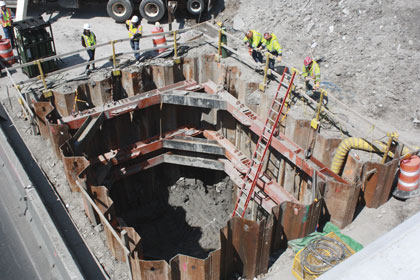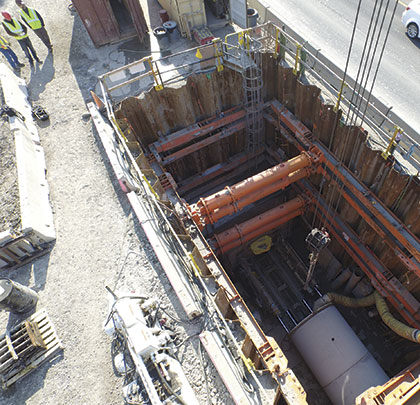Eight hundred, ninety-five feet—that was the distance Chicago-based contractor James McHugh Construction Company had to install 84-inch reinforced concrete pipe (RCP) as part of the WB 290 Flyover Project (Contract 60W28). McHugh subcontracted Dynamicx Enterprises to install the shoring, and tunneling contractor LJ Keefe Company to do the pipe jacking/tunneling. Keefe planned to use a 102-inch diameter tunnel boring machine (TBM). This is simple enough on the surface, but below the surface is where things get interesting.
THE PROJECT
In order to do the tunneling, LJ Keefe required a jacking pit with an inside dimension of 20-feet wide by 40-feet long by 32-feet deep. They needed 24-foot clear (minimum) in the front bay of the pit to bring in pipe and remove spoil. The tunneling also required a thrust block 12-feet high by 22-feet wide by 8-feet thick. The receiving pit had an inside dimension of 21-feet, ¼-inch wide by 29-feet, 4¼-inches long by 25-feet deep.
“For a project like this, normally we would quote a slide rail system,” notes Bill Stanley, sales representative for Lee Jensen Sales, out of Crystal Lake and New Lenox, Illinois. “We were within 5 feet of active traffic on Westbound I-290 for both the receiving and jacking pits, as well as having a building 65 feet from the receiving pit; we had to come up with something else. As we started digging into the parameters of the project, it was about as challenging as you’d see for an earth retention system: tight work spaces, deep cuts, poor soils, heavy surcharge loads, and large clearances—horizontal and vertical—required.”
THE SOLUTION
That nearby building proved to be a big area of concern for the whole project. Officials were concerned about building settlement, roadway, and bridge support, as well as many active utilities in the area. As such, the requirement that any shoring used could deflect no more than 1 inch.
“When Lee Jensen Sales contacted us about the project, my first thought was it could be done using Slide Rail,” mentions Joshua Thorne, Pro-Tec Equipment’s shoring manager, “but when the talk of no more than 1-inch deflection came up, I knew that could only be done by one thing: sheeting. For Pro-Tec Equipment, that meant the Pro-Brace.”
The Pro-Brace System is the only large sheeting and bracing system 100 percent designed and built in the U.S. The system consists of enclosed hydraulic rams and static extensions, which can be stacked and staged on top of each other during initial installation to help speed up installation time.

Featured Image: In order to do the tunneling, LJ Keefe required a jacking with a 24-foot clear (minimum) in the front bay of the pit to bring in pipe and remove spoil.
Above: Due to the location, any shoring used could only deflect 1 inch, making the Pro-Tec Equipment Pro-Brace the right choice.
TIME AND LABOR SAVED
At the time that Dynamicx contacted Lee Jensen Sales, Pro-Tec Equipment had a Pro-Brace project going on in Utica, Michigan. “We [Pro-Tec Equipment] invited Bill from Lee Jensen Sales and Alfonso from Dynamicx to visit the jobsite to see the system in action,” notes Thorne. That turned out to be the key.
“Seeing the system in action was nice,” comments Alfonso Arrambide, project manager for Dynamicx, “but talking with the contractor is what really sold me. He told me the amount of time and labor they saved using this system.”
Time is saved by the nature of the Pro-Brace Hydraulic Frame. Instead of the traditional cut and weld style, the Pro-Brace system can be hydraulically pumped in to position. This action allows the Pro-Brace system to be used in irregular shapes and enables it to account for any sheet bowing that may take place. Each ram in the system can be individually adjusted to fit the need of that side.
“At first, I had a bit of sticker shock when Bill gave me the quote for the system,” mentions Arrambide, “but the savings in terms of labor more than made up for it. We cut our labor by about half, compared to doing a traditional cut and weld or beam and lag job.”
SYSTEM SUCCESS
Starting the project in the middle of a cold Chicago winter was not ideal, but after a short adjustment period, both the Pro-Brace system and the installation crew found their stride. The excavation part of the project was done by Dynamicx using a Link Belt 460 and a Terex TC 50 mini excavator to dig inside the system. The sheets (PZ-27) were installed by Michels Foundations (subcontracted by Dynamicx) using an ABI Mobilram 14-17V hammer. “There were some initial hiccups with the project,” notes Arrambide, “but the system overall worked better than I had expected.”
After nearly 4 months in the ground (jacking pit for 4 months, receiving pit for 1 month), the system allowed the tunneling crew to successfully tunnel the 895 feet in 6 weeks. When asked if he would use this system again on a pipe jacking or tunneling project, Alfonso Arrambide answered simply, “I would definitely use this system again.” ■
About the Author: Tommy Marciniak is the marketing manager for Pro-Tec Equipment, and an all-round awesome guy. He can be reached at 800.292.1225, or by email at tommy.marciniak@trin.net. Pro-Tec Equipment has been a leading producer and distributor of trench shield and trench shoring products since 1995. For more information, visit www.pro-tecequipment.com.
_________________________________________________________________________
Modern Contractor Solutions – July 2016
Did you enjoy this article?
Subscribe to the FREE Digital Edition of Modern Contractor Solutions magazine.

Eight Hundred, Ninety-Five Feet


